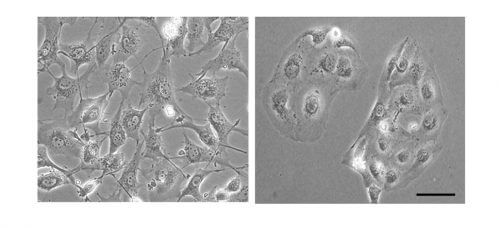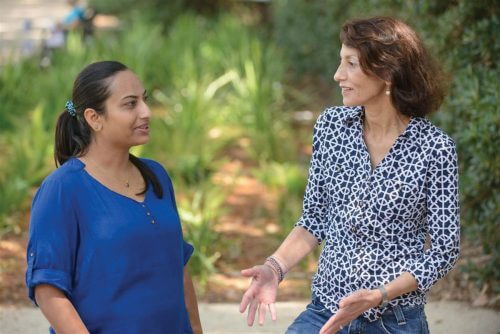How can breast cancer be treated, whose cells do not contain the three receptors used as targets for drugs in other types of breast cancer? And also recommendations of the Cancer Society for women of all ages

the question: How can breast cancer be treated, whose cells do not have the three receptors used as targets for drugs in other types of this cancer?
Findings: The institute's scientists focused on the transition of the cancer from a stable state to an invasive state, and identified a kind of molecular switch that plays a key role in this process, which may be used in the future as a target for breast cancer treatment.
Prof. Sima Lev from the Weizmann Institute of Science aims to defeat a particularly threatening type of breast cancer. Of course, a cancer diagnosis is never good news, but the particular type of malignant breast tumor that Prof. Lev deals with makes the treatment particularly difficult. This type is called triple negative, because its cells do not have the same three receptors that are used as drug targets in other types of breast cancer. With no targets to which drugs can bind, treatment options are extremely limited, and even when chemotherapy does work - the cancer is so aggressive that it sometimes returns. Even when the tumor is detected at a very early stage, there is a great chance that it has already managed to creep into distant body organs, eventually causing metastases.

In a new study, published in the scientific journal Nature Communications, Prof. Lev and post-doctoral researcher Dr. Nandini Verma, from the Department of Molecular Biology of the Cell, brought up new insights into breast cancer of the triple deficiency type, and these may help in the future in the treatment of these malignant tumors. The scientists focused on the process that takes place in all cancer cells in order to create metastases. This is a transition from a relatively stable state, in which the cells maintain normal contacts with neighboring cells and with the intercellular pattern, to a more invasive state - during which their shape elongates, the structural components that allowed them to connect to the environment are lost, and they begin to spread in the body.
The scientists identified a kind of molecular switch - an enzyme called PYK2 - which plays a key role in the transition to the invasive state. About two decades ago, when Prof. Lev discovered this enzyme, she showed that it transmits signals leading to the growth, division, and mobility of cells. In a healthy state, when the cell is growing, for example in the fetus or during wound healing, these signals are essential. In the new study, Dr. Verma - in collaboration with Omer Keenan and Michael Slitternik, also from Prof. Lev's group - revealed how this enzyme encourages the formation of breast cancer metastases.
In the first step, the scientists found that the enzyme causes the cells to become invasive by prolonging the normal signal it produces, and it begins to act like a stuck doorbell that doesn't stop ringing. They later discovered that in triple deficiency cancer two different mechanisms lead to this condition.
First - by weakening the switch that normally stops the signal - the enzyme causes the signal that leads to the switch to the invasive state to remain on for a long time. At the same time, the enzyme works in a kind of continuous positive feedback pattern - it transmits a signal that promotes the transition to an invasive state, and at the same time increases the very production of the enzyme itself, so that its level in the cell continues to rise. These two mechanisms lead to the fact that the signal leading to the transition of the cells to an invasive state continues to operate for a long time, causing more damage.
The scientists tested close to 100 tissue samples from breast cancer patients, and found that in more aggressive tumors the level of the enzyme was higher. Furthermore, in patients whose disease had spread to the lymphatic vessels, the level of the enzyme was higher than in patients whose cancer had not spread to these vessels. When the scientists engineered the cells in the laboratory to eliminate the enzyme, the invasive cells returned to their normal state - evidence that indeed, this enzyme acts as a master switch that enables the transition to the invasive state.
In view of these findings, it is possible that the PYK2 enzyme will be used, in the future, as a target for a new treatment of triple deficiency breast cancer, through the development of small molecules that will block its harmful signal. Such molecules could possibly, in the future, be used as a drug, in combination with other drugs against breast cancer.
Science books: About a fifth of all breast cancer cases are of the triple deficiency type. In other words, more than 300,000 women worldwide are diagnosed with this type of malignant tumor every year.
The Cancer Society recommends for International Women's Day
You can reduce the risk of getting cancer!
Adopt a healthy lifestyle, follow the rules for a healthy life, follow the recommendations for early diagnosis of cancer.
- What is important for you to do?
• Increase physical activity at any age.
• Maintain a healthy weight and eat healthy (maintain a diet high in fiber, fruits and vegetables and two glasses of water).
• Take care of controlled exposure to the sun. Stay in the sun during the safe hours (until 10 am and after 16 pm), stay in the shade, in appropriate clothing, a hat and sunglasses.
• At any age and in any situation if you feel any change or a lump, go get tested and demand to find out the nature of the change.
• Be sure to carry out tests for the early diagnosis of cancer according to the recommendations:
From the age of 50 and over: for an early diagnosis of breast cancer, be sure to perform a mammogram once every two years. Carriers of genetic mutations are also eligible for an MRI scan, and women with a family history are advised to consult the doctor. For an early diagnosis of colon cancer, be sure to perform a fecal occult blood test once a year, and if you are at high risk, a colonoscopy according to the doctor's recommendation.
From the age of 25 to 65: for an early diagnosis of cervical cancer, perform a cervical surface examination once every three years. For an early diagnosis of skin cancer, perform periodic skin tests at the dermatologist. If you are at high risk because of a family history, a genetic mutation or if you have had cancer, you are required to follow up according to the doctor's instructions. - It is also important that you make sure whether you have a hereditary tendency to breast and ovarian cancer. The "Family Story" questionnaire on the Cancer Society website intended to help you find out.
What is important that you don't do?
- Avoid smoking. Smoking will cause wrinkles, yellow teeth, bad breath and cancer, as well as other diseases.
- Avoid exposure to secondhand smoke, don't let us smoke near you!
- Avoid alcohol consumption (in any case, limit it to one glass per day).
- Reduce the consumption of food high in animal fat, processed, smoked, fried, canned, and with a lot of salt.
- Avoid consuming drinks sweetened with sugar and artificial sweeteners.
- Avoid a 'sedentary' lifestyle.
- Avoid excess weight.
- Avoid exposure to substances known to be carcinogenic (asbestos, radon, etc.).
